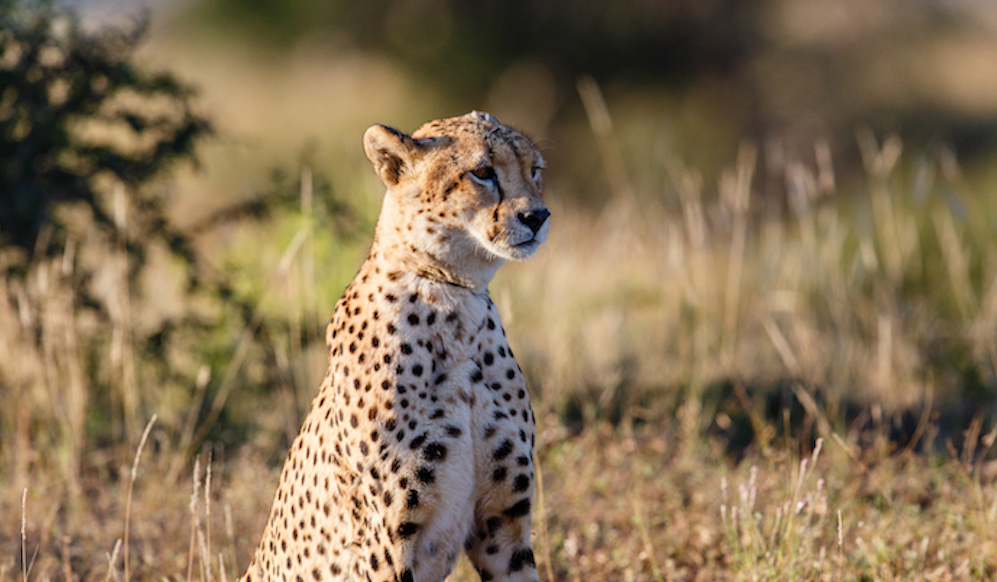For Cheetahs Speed Is Important, but So Is Eyesight
-

- by Meredith Hanel June 22, 2020

Cheetah bodies are built with the speed and manoeuvrability to chase down prey over a 200-meter sprint while reaching speeds of up to 113 km/h, even while turning 180 degrees.
Open grasslands and savanna are where most wild cheetahs live and where they are well adapted to hunt. In addition to speed, cheetahs use their vision to hunt, from spotting prey from 5 km away to locking their eyes on the prize during the chase. During those high-speed chases, cheetahs maintain their head posture and gaze thanks to their brain receiving information from specially adapted structures in their inner ears. Cheetahs also have a way to stop the glaring sun from obstructing their view. Those black tear marks, also called malar stripes that run down from their eyes down the sides of their face, attract the sun away from the eyes. The same strategy is used by football players who put black smudges under their eyes.
Adapted to Hunting During the Day
Tear marks give cheetahs a distinct look not found on any other cats, which makes sense since other large cats mainly hunt at night when they don’t need to worry about the bright sun. It is thought that cheetahs have adapted to hunting during the day in order to avoid competing with larger carnivores like lions, leopards and hyenas. Unlike those nocturnal hunters, cheetahs see better during the day than at night. This is because cheetahs have more cone photoreceptor cells and fewer rod photoreceptor cells in their retina compared with other cats. A specific type of cone photoreceptor called S cones are much more abundant in cheetah retinas than other cats, which are expected to enhance their ability to discriminate colours.
Cheetahs with their high-set eyes are able to gaze over a wide area, with a 210-degree field of view whereas people can see objects within only 140 degrees. In addition to the position of their eyes, adaptations in the distribution of cells in their retina help them scan the horizon with better acuity. Visual streaks are elongated oval regions of higher cell density which may be in a horizontal or vertical direction. The horizontal streak is more common in vertebrates in open habitats where their visual field is dominated by the horizon, allowing them to have a panoramic view without needing to move their eyes as much. Species that inhabit open environments such as the cheetah, pig and deer were found to have horizontal streaks of increased concentration of a certain type of photoreceptor cells.

Restoring Open Habitats
Cheetahs cannot use their spectacular vision and speed in areas where open grasslands have been taken over thorn bush. Bush encroachment, one of the ways cheetahs are losing their habitat, is a form of desertification caused both by overgrazing and the decline of large mega-herbivores. Moving through thorn bush causes cheetahs sustain eye injuries and they are more likely to consider preying on farm livestock, putting them in danger due to conflict with humans. Bush encroachment also makes land unusable for farming. CCF established the award-winning Bushblok Company which manufactures an environmentally friendly high heat low emission fuel log called Bushblok that is harvested from thorn bush. The program makes the land more productive and at the same time grasslands are restored for cheetahs.
Photos by Craig Taylor, Ottawa
Other article: Inner ear built to handle speed
References:
Cheetah Conservation Fund Education Centre Web Tour – Text Version.
Cheetahs’ inner ear is one of a kind, vital to high-speed hunting. Science Daily (2018, February 02).
Ahnelt, Peter & Schubert, C & Kübber-Heiss, Anna & Anger, E. (2005). Adaptive Design in Felid Retinal Cone Topographies. Conference: ARVO 2005, Ft Lauderdale
Gagne, T. (2012) Cheetahs. Minnesota: Capstone Press.
Hughes A. (1977) The Topography of Vision in Mammals of Contrasting Lifestyle: Comparative Optics and Retinal Organisation. In: Crescitelli F. (eds) The Visual System in Vertebrates. Handbook of Sensory Physiology, vol 7 / 5. Springer, Berlin, Heidelberg
Einat Hauzman, Daniela M.O. Bonci and Dora F. Ventura (2018). Retinal Topographic Maps: A Glimpse into the Animals’ Visual World, Sensory Nervous System, Thomas Heinbockel, IntechOpen, DOI: 10.5772/intechopen.74645.
Marker, L. (2019). Cheetahs Race for Survival: Ecology and Conservation, Wildlife Population Monitoring, Marco Ferretti, IntechOpen, DOI: 10.5772/intechopen.82255.
Marker, L. (2012) Biomass Energy: Burning Bushes to Save Cheetahs. Huffinton Post (09/17/2012).
Meachen, J. et al. (2018) ‘Cheetah Specialization: Physiology and Morphology’, in Nyhus P. (ed.) Cheetahs: Biology and Conservation. Academic Press.
Stay up-to-date...
with the activities of Cheetah Conservation Fund in Canada, Namibia and Somaliland. We send semi-annual newsletters and info about special events and initiatives. We do not share your email address with any other organization.
Related Reading
-
December 4, 2024
The Role of A Cheetah Keeper at CCF -
November 16, 2024
Cheetah Keepers – All About the Cheetahs! -
November 14, 2024
Let’s #SaveTheCheetah in the Wild Together!



